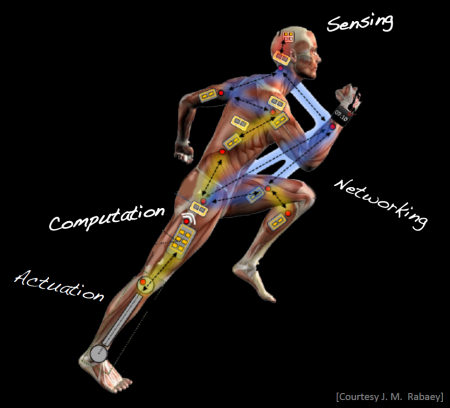Difference between revisions of "A Demonstrator of Non-Synchronized Hyperdimensional Body Area Networks"
From iis-projects
(Created page with "Category:DigitalCategory:In progressCategory:Available Category:Semester Thesis Category:Master Thesis Category:2019Category:HotCategory:Human In...") |
(No difference)
|
Revision as of 17:43, 12 July 2019
Contents
Description
A body area network connects body sensors and actuators with a central device, which ultimately enables connectivity with the external world. Usually, the sensor data is preprocessed and classified on the sensor node and sent to the central device using protocols like BLE or Zigbee.
Alternatively, the data can be represented with high-dimensional vectors (aka hypervectors), where the dimension is in 1k-10k. Key feature of high-dimensional representation is its robustness against noise – flipping 1/3 of the bits still allows recovery with high probability. Hyperdimensional computing has already shown great capabilities in classifying Electromygraphy (EMG) data for gesture recognition [1].
This project aims to build a demonstrator which connects multiple EMG sensor nodes with a central device by exchanging EMG data with hyperdimensional vectors. The robustness against noise makes synchronization between nodes unnecessary. You build up on an existing sensor hardware which consists of an ATMEL [2] chip connected with an FPGA. A software defined radio receives (SDR) the signal of multiple sensor nodes. The signal processing can be implemented in Matlab.
The main tasks of the project is the programming of the FPGA, configuration of the SDR, and the evaluation in Matlab. Eventually, the system has to be tested thoroughly.
Status: Available
- Looking for 2 students for a semester project or 1 student for a master thesis.
- Supervision: Michael Hersche, Philipp Mayer
Prerequisites
To work on this project, you will need:
- Basic knowledge or interests in signal processing and wireless communication
- Knowledge in Matlab, C and/or VHDL is of advantage
Character
- 20% Theory
- 50% Implementation
- 30% Testing
Professor
Literature
- [1] A. Moin et al, An EMG Gesture Recognition System with Flexible High-Density Sensors and Brain-Inspired High-Dimensional Classifier
- [2] Atmel AT86RF215 Device Family
